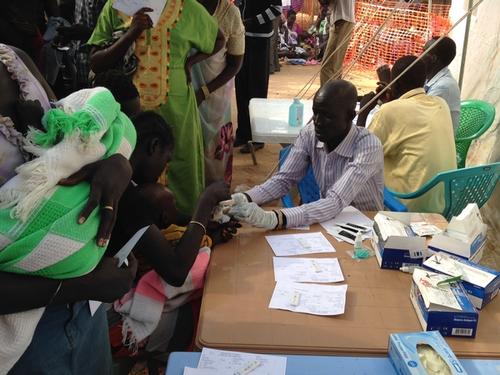An estimated 40,000 people have sought refuge in two UN compounds in Juba, South Sudan, following violence that erupted in the city in mid-December 2013. MSF began running clinics in Tomping camp and Juba 3 camp in December 2013 where medical activities continue today.
In Tomping camp, more than 27,000 people live in a desperate environment, unable to return home. MSF teams are seeing an increasing number of critical cases of measles and diarrheal diseases. MSF’s Emergency Coordinator, Forbes Sharp, gives an update on the dire conditions for people in this camp, how MSF is responding, and what more must be done.
What is the current situation in Tomping camp in Juba, where thousands of displaced people have settled?
There is really only one way to describe Tomping – exceptionally overcrowded. When you drive into the camp, you see people living on the side of the road under bushes, trying to eke out a small space for themselves and their families. It’s clear this compound was never designed to be a displaced camp, nor to hold this number of people. At most it could host 4,000-5,000 people and now more than 27,000 people are crowded here in extreme heat, living in impossible conditions.
From a public health point of view, such crowded conditions are a ticking time bomb. Communicable diseases spread quickly in this kind of environment, especially with such inadequate sanitation. It is difficult to find space to build latrines and people are struggling to maintain basic hygiene. As a result, we see high numbers of diarrhoeal diseases in our clinic, which in this context can kill.
In an emergency the aim is to have one latrine for every 50 people. In Tomping there is one for every 150 people, not close to what is needed. There are many organisations on the ground doing their best and trying to find space and build more, but as soon as more are built, they’re full. The lack of space makes working here for all the humanitarian community extremely difficult.
What is MSF doing to support the displaced in Tomping?
A few weeks ago we started to see more and more cases of measles, a viral disease that starts with red eyes, a runny nose and cough, and then a rash that begins to spread. Measles weakens the immune system, making children in particular very weak and susceptible to super-infections. Measles in a camp setting is alarming because it affects young children, spreads quickly and can kill.On 22 December, our emergency team opened an outpatient clinic in Tomping camp, where we have since treated more than 7,700 people, typically for diarrheal diseases, respiratory tract infections and malaria.
In response to this we set up a second facility to care for critically ill paediatric cases, with 24-hour high-level care. So far we’ve had 163 admissions, nearly all of whom are children under the age of five. Our paediatric ward has been operating at 150% capacity since it opened, with half the cases presenting with measles, arriving in a very poor state of health.
Despite our very best efforts, we have lost 16 patients since the facility opened. We are now doubling the size of our paediatric ward and sending out community health teams to encourage people to bring their children to hospital much sooner, before they’re critically ill. The earlier they’re brought to hospital, the more lives we can save.
What are the main challenges you face?
Space. It’s the problem we all face in working in Tomping. Our clinic is about the size of a tennis court, where we regularly treat more than 200 patients per day. When the clinic is really busy in the early morning, there’s hardly space to walk through from one side to the other. Space is so valuable that people have set up little tents that line the fence around our clinic – that’s their home.
The heat is staggering and with such poor sanitation, children are contracting diarrhoea which leads to dehydration. One little girl who was brought to the paediatric ward was so dehydrated that her veins had collapsed. One of the MSF nurses, Anna, spent more than five hours with her, feeding her through a gastro tube, and though she began to revive slightly, it was too late and she sadly died later that night.
What are your concerns for the displaced? What more needs to be done?
We are very worried about the effect that the living conditions in the camp are having on people. New data from the whole of Tomping camp, including data from MSF, indicates that the number of people dying in the camp every day is above the emergency threshold. We are analysing this data further to gain more clarity on the exact figures and the reasons for these high rates.
Meanwhile, we have reinforced our MSF team by doubling the size of the paediatric ward and the number of nurses and doctors, improving community outreach to encourage people to come forward for treatment earlier, and putting in place mortality surveillance systems. At the same time we are talking to the other organisations on the ground about what more we can all do to address the situation. We think that there needs to be more space made for latrines and an additional outpatient clinic.
Living in such congested and harsh conditions, people are incredibly vulnerable to disease which makes each day a battle. The worrying part for me is that Tomping is only a fraction of the suffering of the more than 800,000 people who have been displaced from their homes across South Sudan.



